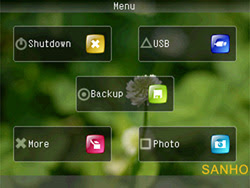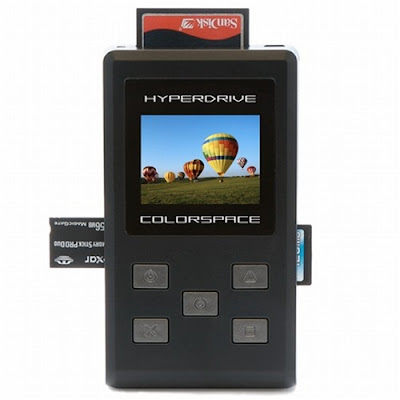There are gadgets related to photography that are fun, cool, and nice to have but that does not make them
"must have".But my new
ColorSpace from
Hyperdrive is fun, cool,
AND a must have.
Before I ever turned on my
120GB "
Hard drive with an LCD screen" I was a happy guy, too often when you buy an item that's all you get, you have to buy the case or the car charger, but when I opened the box I knew this was a good thing. It came with a house charger, car charger, a USB cable to interface with and charge from your computer. It also came with a heavy duty padded case that has a reinforced loop on it so you can strap that bad boy to your belt and have it with you as you shoot.
And this may not be a big thing to you, but it is to me, it came with a printed manual, it seems the standard now is to get the documentation on CD which is useless when you find yourself shooting on location (which is most of the time). Calling it a manual is a little miss-leading, it's really more of a small pamphlet, about 20 pages with more pictures than words.
The
Hyperdrive is so intuitive to use that you don't really need the instructions, but I thought the fact that they were included represented the thoughtfulness and thoroughness that went into the product. Back to the ease of use, I handed it to one of my 11 year old twins and asked her to
"show me the pictures" and she had me there in no time flat (she took great pride in thinking she did it faster than I had).
Those who have read this blog for any time know that I am
a big advocated on backing up your images, and the
Hyperdrive is another tool (the missing link) in that strategy.

The motivation for getting this was to be able to backup my images/cards while on location, it gives me great comfort in knowing that before I even leave the wedding I have a backup copy of all my images. Here are just a few of the things I really like about it:
1. It's fast, really fast, with transfer rates of 1 GB a minute.
2. The screen is beautiful - a 2.2 inch high-res color LCD display.
3. It displays both JPG and RAW (with histogram, iso, f/stop, shutter speed, etc.).
4. The battery seems to last forever - I downloaded 5GB worth of images, played with them for awhile, then put the my Hyperdrive on the shelf for a full month and when I turned it back on the battery was still fully charged.
5. What I did not know until I got it was that is also comes with some way cool memory card tools - it will repair and recover images. I grabbed an "empty" card (one I had downloaded and deleted the images from) and sure enough it found all of the images I thought to be gone. How neat is that?!
6. It can also verify of your memory card is in fact authentic (vs. counterfeit).
Most of the time I will get a photography doo dad and be glad to have it, this is the rare occasion where I wish I had gotten it a long time ago.
The measure of importance is what would you did if an item is lost or stolen, well, if something happened to my
Hyperdrive I would order another one before the that day came to an end.



















